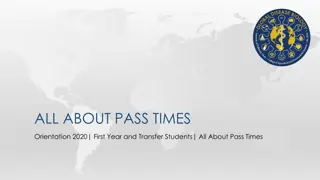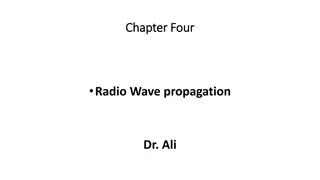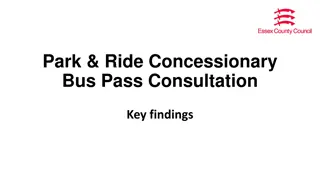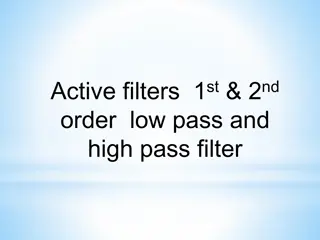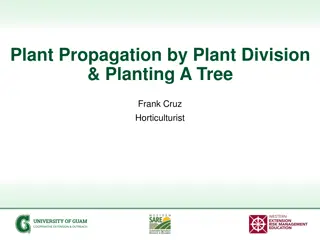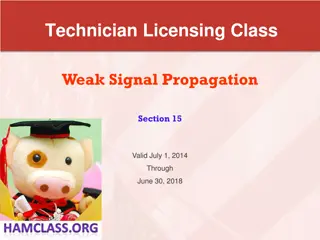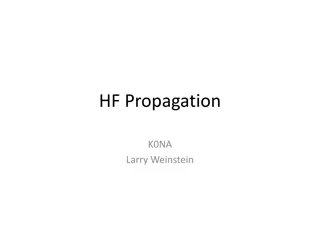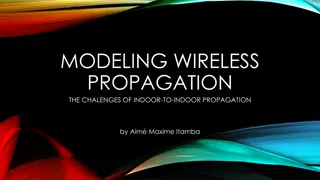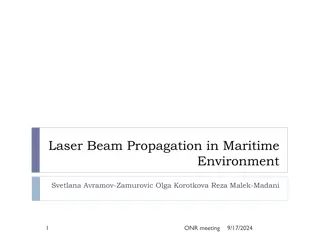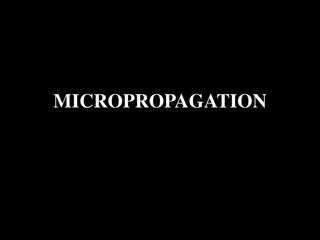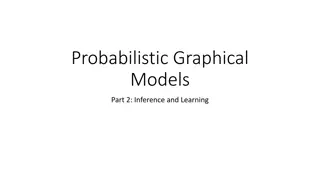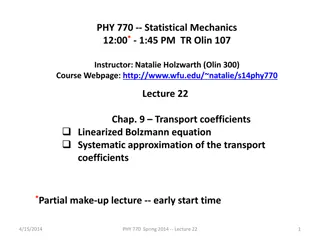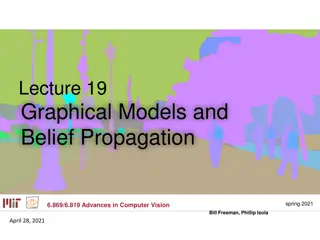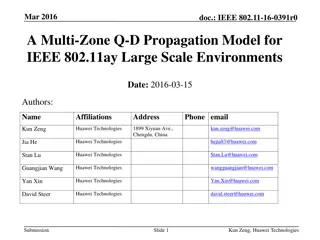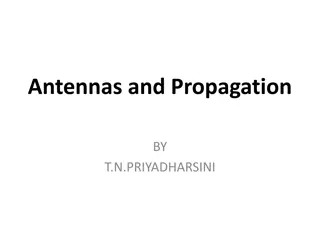Linearized and Single-Pass Belief Propagation
This article discusses the concepts and techniques related to linearized and single-pass belief propagation as presented in the research paper by Wolfgang Gatterbauer et al. It covers topics such as homophily, heterophily, affinity matrices, and the challenges faced in belief propagation with graphs containing loops. The roadmap includes background on belief propagation, the proposed solution called LinBP, experiments, and conclusions. Belief propagation models by Pearl and solutions like Echo Cancellation are explained, highlighting the iterative message passing approach. The details of belief propagation by Pearl and Weiss are outlined, emphasizing message calculation and belief convergence.
Download Presentation

Please find below an Image/Link to download the presentation.
The content on the website is provided AS IS for your information and personal use only. It may not be sold, licensed, or shared on other websites without obtaining consent from the author.If you encounter any issues during the download, it is possible that the publisher has removed the file from their server.
You are allowed to download the files provided on this website for personal or commercial use, subject to the condition that they are used lawfully. All files are the property of their respective owners.
The content on the website is provided AS IS for your information and personal use only. It may not be sold, licensed, or shared on other websites without obtaining consent from the author.
E N D
Presentation Transcript
? ? ? Linearized and Single-Pass Belief Propagation ? ? ? ? ? ? Wolfgang Gatterbauer, Stephan G nnemann1, Danai Koutra2, Christos Faloutsos VLDB 2015 (Sept 2, 2015) 1 Technical University of Munich 2 University of Michigan 1
"Birds of a feather..." (Homophily) "Opposites attract" (Heterophily) ? Follower Leader ? Liberals Conservative Leader "Guilt-by-association" recommender systems semi-supervised learning random walks (PageRank) Disassortative networks biological food web protein interaction online fraud settings Affinity matrix (also potential or heterophily matrix) 1 2 1 2 1 0.8 0.2 2 0.2 0.8 1 0.2 0.8 2 0.8 0.2 H = H = 2
The overall problem we are trying to solve ? ? 1 2 3 ? 1 0.1 0.8 0.1 2 0.8 0.1 0.1 3 0.1 0.1 0.8 ? ? H = ? ? k=3 classes ? ? Problem formulation Given: undirected graph G seed labels affinity matrix H (symmetric) remaining labels Good: Graphical models can model this problem Bad: Belief Propagation on graphs with loops has convergence issues Find: 3
Roadmap 1) Background: "BP" Belief Propagation 2) Our solution: "LinBP" Linearized Belief Propagation 3) Experiments & conclusions 4
Belief Propagation Pearl [1988] Message mst from s to t summarizes everything s knows except information obtained from t ("echo cancellation" EC) mst s t Belief Propagation Iterative approach that sends messages between nodes Repeat until messages converge Result is label distribution ("beliefs") at each node 0.1 0.8 0.1 bt= Problems on graphs with loops: Approximation with no guarantees of correctness Worse: algorithm may not even converge if graph has loops Still widely used in practice 5
Belief Propagation DETAILS Pearl [1988] Weiss [Neural C.'00] mst ... ... s t ... ... (1) (2) 1) Initialize all message entries to 1 2) Iteratively: calculate messages for each edge and class "echo cancellation" EC affinity explicit beliefs 3) After messages converge: calculate final beliefs 6
Belief Propagation DETAILS Illustration 0 4 0.1 0.9 0.9 0.1 (...)= H= mst ... ... s t ... ... (1) (2) 3.6 0.4 0.9 0.1 mst = 1) Initialize all message entries to 1 2) Iteratively: calculate messages for each edge and class "echo cancellation" EC affinity matrix explicit beliefs 0 2 1 2 0 4 = component-wise multiplication 3) After messages converge: calculate final beliefs Often does not converge on graphs with loops 7
Roadmap 1) Background: "BP" Belief Propagation 2) Our solution: "LinBP" Linearized Belief Propagation 3) Experiments & Conclusions 8
Key Ideas: 1) Centering + 2) Linearizing BP Original Value Center point = Residual + 1 0.1 0.8 0.1 0.8 0.1 0.1 0.1 0.1 0.8 1/3 1/3 1/3 1/3 1/3 1/3 1/3 1/3 1/3 -0.23 0.46 -0.23 0.46 -0.23 -0.23 -0.23 -0.23 0.46 = + 0.2 0.6 0.2 1/3 1/3 1/3 -0.13 0.26 -0.13 = + 1.1 0.8 1.1 1 1 1 0.1 -0.2 0.1 = + 2 9
Linearized Belief Propagation DETAILS not linear EC BP EC linear LinBP no more normalization necessary 10
Matrix formulation of LinBP DETAILS Update equation s t t t t t + s affinity matrix + final beliefs (n x k) explicit beliefs graph degree matrix EC EC Closed form Spectral radius of (...) < 1 Scale with appropriate : Convergence 11
Roadmap 1) Background: "BP" Belief Propagation 2) Our solution: "LinBP" Linearized Belief Propagation 3) Experiments & Conclusions 12
Experiments 1) Great labeling accuracy (LinBP against BP as ground truth) 2) Linear scalability (10 iterations) 42min BP precision 100k edges/sec LinBP 4sec recall | | 67M LinBP & BP give similar labels LinBP is seriously faster! Reason: when BP converges, then our approximations are reasonable Reason: LinBP can leverage existing optimized linear algebra packages 13
What else you will find in the paper and TR Theory - Full derivation SQL (w/ recursion) - Implementation with standard aggregates Single-pass Belief Propagation (SBP) - Myopic version that allows incremental updates Experiments with synthetic and DBLP data set 14
Take-aways Goal: propagate multi-class heterophily from labels Problem: How to solve BP convergence issues Solution: Center & linearize BP convergence & speed t + s + Linearized Belief Propagation (LinBP) - Matrix Algebra, convergence, closed-form - SQL (w/ recursion) with standard aggregates Single-pass Belief Propagation (SBP) - Myopic version, incremental updates http://github.com/sslh/linBP/ Thanks 15
BACKUP 16
More general forms of "Heterophily" Potential (P) 1 1 8 1 2 8 1 1 3 1 1 8 1 2 3 class 1 (blue) class 2 (orange) class 3 (green) Class-to-class interaction Affinity matrix (H) 1 2 3 0.8 1 0.1 0.8 0.1 2 0.8 0.1 0.1 3 0.1 0.1 0.8 0.1 0.1 0.1 0.1 0.8 17
BP has convergence issues DETAILED EXAMPLE Edge potentials Explicit beliefs A B -3 0.9 0.1 0.1 0.9 0.9 0.1 H = eA=eB= 2 1 2 Nodes w/o priors: eC=eD= Edge weights 3 3 0.5 0.5 C D Hij' Hijw BP BP with damping=0.1 0.94 C A 0.51 0.59 0.48 1) no guaranteed converge 2) damping: many iterations 18
BP has convergence issues DETAILED EXAMPLE Edge potentials Explicit beliefs A B -3 0.9 0.1 0.1 0.9 0.9 0.1 H = eA=eB= 2 1 2 Nodes w/o priors: eC=eD= Edge weights 3 3 0.5 0.5 C D Hij' Hijw BP with damping=0.1 BP with different parameters BP 0.94 C A 0.51 0.59 0.48 3) unstable fix points possible 1) no guaranteed converge 19
LinBP can always converge DETAILED EXAMPLE Edge potentials Explicit beliefs A B -3 0.9 0.1 0.1 0.9 0.9 0.1 H = eA=eB= 2 1 2 Nodes w/o priors: eC=eD= Edge weights 3 3 0.5 0.5 C D Hij' Hijw LinBP with ( / conv) = 0.1 BP 0.85 0.94 C A 0.53 0.51 LinBP: guaranteed converge 1) no guaranteed converge 20
LinBP in SQL 21
Single-Pass BP: a "myopic" version of LinBP v2 v2 v4 v4 g=1 v1 v1 g=2 v5 v5 v3 v3 v6 v6 v7 v7 22
POSTER 23
? ? ? Linearized and Single-Pass Belief Propagation ? ? ? ? ? ? Wolfgang Gatterbauer, Stephan G nnemann1, Danai Koutra2, Christos Faloutsos VLDB 2015 Carnegie Mellon Database Group 1 Technical University of Munich 2 University of Michigan 24
"Birds of a feather..." (Homophily) "Opposites attract" (Heterophily) ? Follower Leader ? Political orientation Leader "Guilt-by-association" recommender systems semi-supervised learning random walks (PageRank) Disassortative networks biological food web protein interaction online fraud settings Affinity matrix (also potential or heterophily matrix) 1 2 1 2 1 0.8 0.2 2 0.2 0.8 1 0.2 0.8 2 0.8 0.2 H = H = 25
More general forms of "Heterophily" Potential (P) 1 1 8 1 2 8 1 1 3 1 1 8 1 2 3 class 1 (blue) class 2 (orange) class 3 (green) Class-to-class interaction Affinity matrix (H) 1 2 3 0.8 1 0.1 0.8 0.1 2 0.8 0.1 0.1 3 0.1 0.1 0.8 0.1 0.1 0.1 0.1 0.8 26
The problem we are trying to solve ? ? 1 2 3 ? 1 0.1 0.8 0.1 2 0.8 0.1 0.1 3 0.1 0.1 0.8 ? ? H = ? ? ? k=3 classes ? Problem formulation Given: undirected graph G seed labels affinity matrix H (symmetric, doubly stoch.) remaining labels Good: Graphical models can model this problem Bad: Belief Propagation on graphs with loops has convergence issues Find: 27
Markov networks (also Markov Random Fields) "Misconception example" Koller,Friedman[2009] Does a student think + or -? Alice Bob B\C + + 0.9 0.1 - 0.1 0.9 - Bob and Charlie tend to agree (homophily) HBC = C\D + + 0.1 0.9 - 0.9 0.1 - Debbie Charlie Charlie and Debbie tend to disagree (heterophily) HCD = Inference tasks Marginals (belief distribution) Maximum Marginals (classification) bD = + 0.6 - 0.4 Maximum Marginal But Inference is typically hard 28
Belief Propagation DETAILS Illustration 2 0 0 0.1 0.8 0.1 0.8 0.1 0.1 0.1 0.1 0.8 H= (...)= s t mst 0.1 0.8 0.1 0.2 1.6 0.2 mst = 1) Initialize all message entries to 1 2) Iteratively: calculate messages for each edge and class multiply messages from all neighbors except t ("echo cancellation" EC) EC edge potential explicit (prior) beliefs componentwise-multiplication operator 3) After messages converge: calculate final beliefs Does often not converge on graphs with loops 29
Illustration of convergence issue with BP Edge potentials Explicit beliefs A B -3 0.9 0.1 0.1 0.9 0.9 0.1 H = eA=eB= 2 1 2 Nodes w/o priors: eC=eD= Edge weights 3 3 0.5 0.5 C D Hij' Hijw BP BP with damping=0.1 Different parameters 0.94 0.51 0.59 0.48 1) no guaranteed convergence 2) damping: many iterations 3) BP can have unstable fix points 30
Properties of "Linearized Belief Propagation" RWR, SSL Linear Algebra LinBP Improved computational properties BP Iterative homoph. heteroph. LinBP properties: Heterophily Matrix Algebra Closed form convergence criteria SQL with recursion Expressiveness 31
Key Idea: Centering + Linearizing BP Original Value Center point Residual = + 0.1 0.8 0.1 0.8 0.1 0.1 0.1 0.1 0.8 1/3 1/3 1/3 1/3 1/3 1/3 1/3 1/3 1/3 -0.23 0.46 -0.23 0.46 -0.23 -0.23 -0.23 -0.23 0.46 = + 0.2 0.6 0.2 1/3 1/3 1/3 -0.13 0.26 -0.13 = + 1.1 0.8 1.1 1 1 1 0.1 -0.2 0.1 = + 32
Linearized Belief Propagation DETAILS not linear EC BP EC linear LinBP Messages remain centered ! 33
Matrix formulation of LinBP DETAILS Update equation s t t t t t + s affinity matrix + final beliefs (n x k) explicit beliefs graph degree matrix EC EC Closed form Spectral radius of (...) < 1 Scale with appropriate : Convergence 34
Experiments 1) Great labeling accuracy (LinBP against BP as ground truth) 2) Linear scalability (10 iterations) 42min BP precision 100k edges/sec 4sec LinBP recall | | 67M LinBP & BP give similar labels LinBP is seriously faster! Reason: when BP converges, then our approximations are reasonable Reason: LinBP can leverage existing optimized matrix multiplication 35
LinBP in SQL 36
Single-Pass BP: a "myopic" version of LinBP v2 v2 v4 v4 g=1 v1 v1 g=2 v5 v5 v3 v3 v6 v6 v7 v7 37
Take-aways Goal: propagate multi-class heterophily from labeled data Problem: How to solve the convergence issues of BP Solution: Let's linearize BP to make it converge & speed it up Linearized Belief Propagation (LinBP) - Matrix Algebra, convergence, closed-form - SQL (w/ recursion) with standard aggregates Single-pass Belief Propagation (SBP) - Myopic version, incremental updates Come to our talk on Wed, 10:30 (Queens 4) 38



